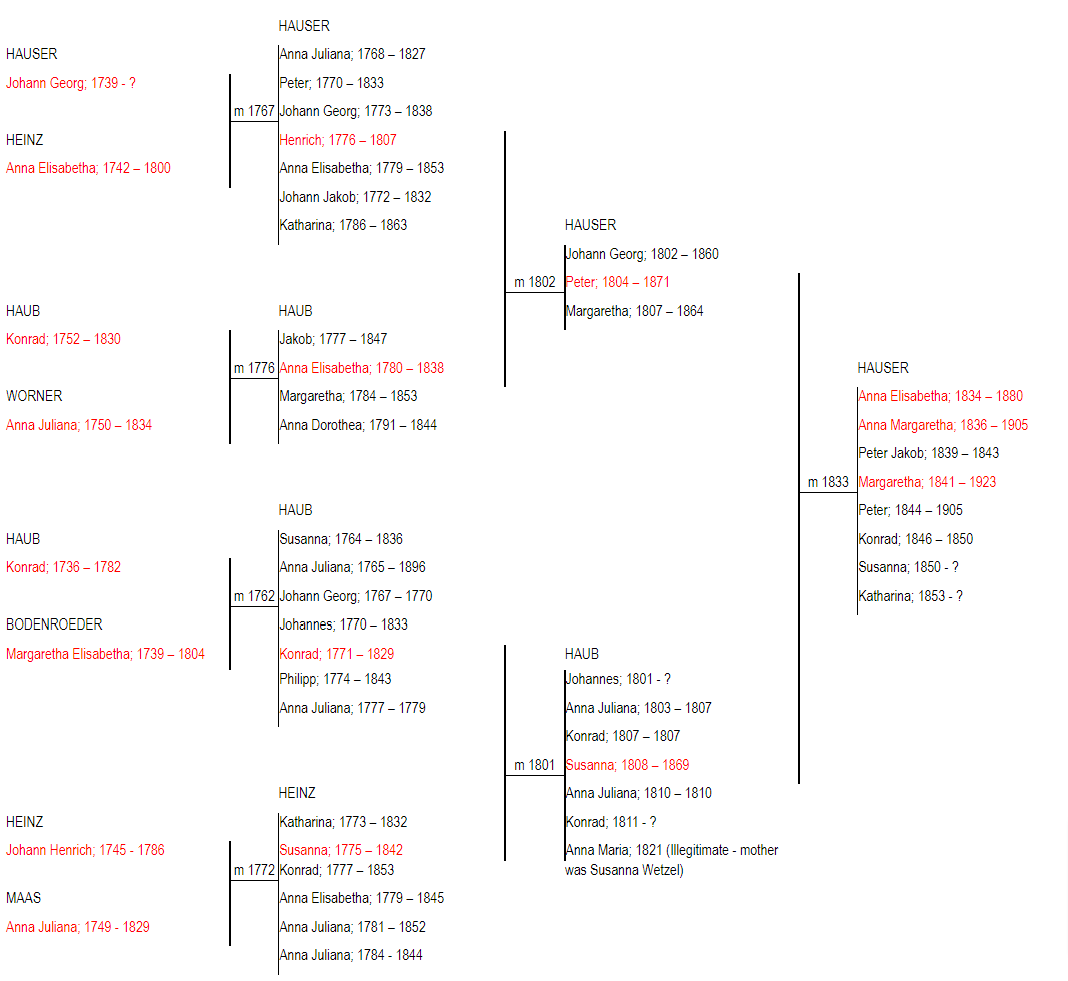Anna Elisabetha HAUSER 1834-1880
Anna Elisabetha was born on 29th October 1834. She was the eldest child of Peter Hauser, a linen-weaver, and Susanna nee Haub. Three brothers and four sisters were born over the next nineteen years in the three-level building that was both factory and home. The children received a basic education and were also taught the skills of animal husbandry.
On 21st December 1855 Anna Elisabetha gave birth to a female child who was baptised Susanna Hauser. Johannes Zimmer, a soldier stationed at Worms but of a local family, acknowledged that he was the father. He and Anna Elisabetha were married on 6th June 1856; the marriage contract legitimised the child as a Zimmer. The newlyweds left for England the next day but the baby was left with her Hauser grandparents; they were never to see her again. On 21st October 1856 they sailed from Liverpool on the clipper ship “Star of the East” and reached Melbourne on 12th January 1857 after 84 days at sea.
Anna Elisabetha became pregnant soon after leaving England. Her baby was born in August in Ballarat, where Johannes was prospecting; the midwife was the wife of Johann Konrad Vorbach from Nieder-Weisel. The baby was baptised Maria Elisabetha. A third girl, Maria Margaretha, was born at Fryers Creek in 1860 and baptised in the Congregational Church, Castlemaine in June. Johannes then took his family to Yandoit, north of Daylesford, where deep lead mines were being worked. There, in 1862, Anna Elisabetha produced her first son, christened Johann Wilhelm.
The family lived near Anna Elisabetha’s two sisters, Anna Margaretha and Margaretha until Johannes went mining at Rocky Lead, 15 km away. Alice Elizabeth was born there in 1864 and Conrad in 1866. The following year, Maria Elisabetha died of enteritis and was buried in the Creswick cemetery. Johannes later returned to Yandoit and the family lived side-by-side with their Fleischer and Maas cousins on the Camp (Yandoit Creek) Road. Ernest was born in the wood-and-iron cottage in 1870. Soon after Anna Elisabetha became pregnant again, Johannes was found to have tuberculosis. He died, at the age of 40, four months after Mary was born.
The Fleischers fostered Ernest whilst Anna, as she was then known, struggled to support the others. She grew vegetables and laundered clothes for unmarried miners in the town. One of them, Konrad Pfeifer, offered marriage and was accepted. The ceremony took place in Daylesford in 1874 and Anna took her family to live in Konrad’s cottage-workshop on the road to Creswick in Rocky Lead. In turn, Konrad taught his three stepsons his trade of boot making. The Pfeifer couple had a baby in 1875; she was baptised Maria Henrietta but known as Hettie. Unhappily, Anna developed tuberculosis not long after this; she died on 11th April 1880 when the little girl was only four.
Anna Elisabetha Pfeifer, formerly Zimmer, born Hauser, went to her last resting place in the Blanket Flat Cemetery. She was buried in a grave that remained unmarked until 1984. At the instigation of a great-grand-daughter, Winsome Menadue, it was marked with a simple stone to commemmorate the 150th anniversary of her birth in Nieder-Weisel.
Her daughters Maria Margaretha and Maria Henrietta died, in 1880 and 1894 respectively, of tuberculosis. Her Victorian-born children all married and produced a total of twenty-six grand-children. In Germany, Susanna also raised a family, some of whom faced their Australian cousins in the mud and blood of the battlefields in France during the Great War.
View Anna Elisabetha's Family Chart

